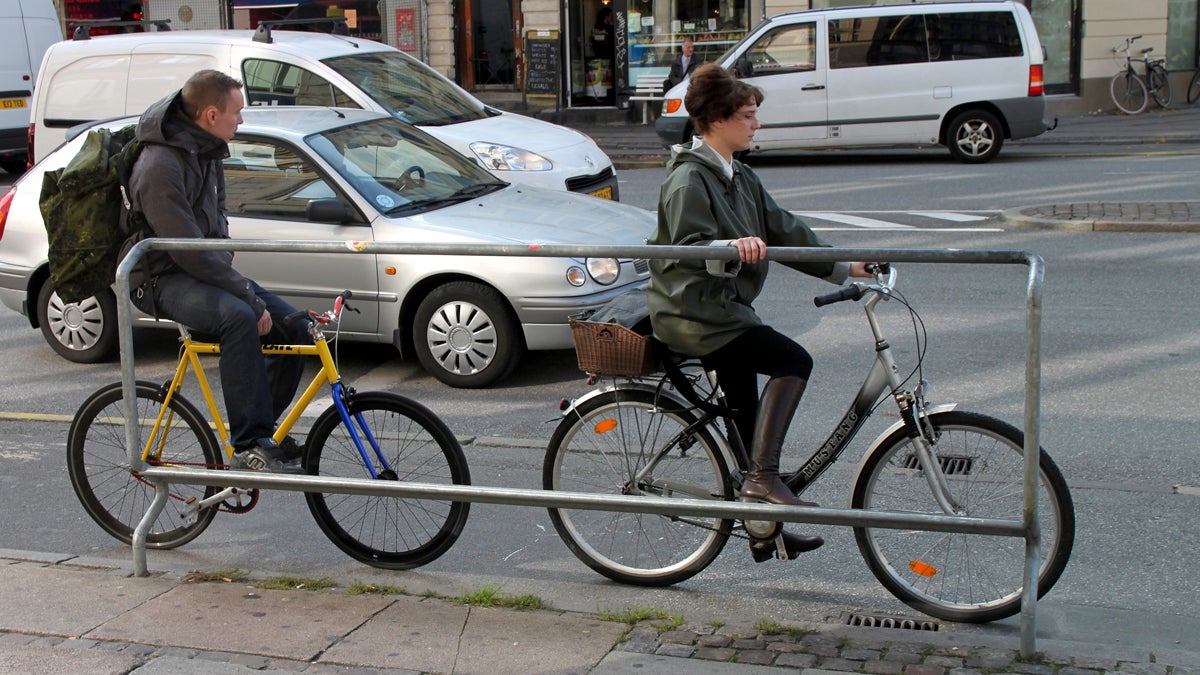Scott Bricker on cycling infrastructure, parking spaces and the Ultraviolet Loop

Two cyclists use a foot rest with handles at a major intersection on a downtown Copenhagen street with bicycle-friendly features. (AP Photo/Jan M. Olsen)
“Five Questions with …” is a regular Keystone Crossroads feature where we seek to glean wisdom and ideas from some of Pennsylvania’s top urban thinkers and doers. Scott Bricker is executive director of Bike Pittsburgh. He’s cycled across the United States and is a daily bicycle commuter in Pittsburgh, Pa.
Q: Tell us about an amenity or service that you’ve seen in your travels to other places that you wish you could bring back to your city/community.
A: I just returned from a trip to Copenhagen with Mayor Bill Peduto and Allegheny County Executive Rich Fitzgerald. The cycling infrastructure there is incredibly bold but at the same time unbelievably simple. There are clear paths where cyclists ride, where cars should drive, and pedestrians should walk. Additionally, there is also a huge effort to calm traffic so that it is completely obvious when you leave a busy car-oriented street and enter onto a neighborhood street. It completely transforms how people interact with the streets, putting the “public” back into public space. And it works. Traffic injuries are fairly non-existent and you see all types of people of all ages biking around to get where they need to go.
Q: What’s one urban improvement idea that you could categorize as “nice try but didn’t work”?
A: I’d say the Ultraviolet Loop experiment from a decade ago in Pittsburgh. This was a free bus that the Port Authority ran that would drive in a continuous loop around all of the neighborhoods with higher concentrations of nightlife, in the hopes of helping get people to what was at the time fairly remote spots of activity in the city while reducing drunk driving. It was a good idea, and I’m not sure why it wasn’t used by more people, but now with more of a density of restaurants and bars it might be time to rethink this concept and give it a shot again. On the other hand, now with Lyft and Uber in town and bike share on the way, maybe that idea is outdated. [Editor’s note: recently a judge ruled that Lyft and Uber must stop operating. Uber is contesting the ruling]
Q: Describe a person in your community who is a “spark” — someone who seems to get things done and inspire people. (This does not need to be an elected official.)
A: I’ve always been in awe of Rich Pell’s intellect, creativity, drive, and sense of humor. His Center for PostNatural History is one of the most impressive works of art in Pittsburgh.
Q: What flaw or habit does your city/community have that you would like to see change?
A: Despite being a dense, urban city with one of the highest rates of active transportation in the country, the majority of traffic engineers in the region still aren’t putting people first in the design of our streets. Moving cars quickly is still their raison d’être, it seems, with pedestrian and bicycle facilities falling far down their list of priorities. A prime example of this is PennDOT’s redesign of Rt 51, which could have been an amazing multimodal corridor with modern protected bikeways that would connect people on bikes all the way to the Airport and provide communities with very low rates of car ownership along the way with new options for mobility. This alternative design would still move cars safely and efficiently. Instead, the design will give far too much space to cars, which will only encourage unsafe driving behavior. People choosing to ride bikes along the corridor will be expected to share a 14-foot travel lane with speeding and weaving cars. That is not people-first design and that needs to change.
Q: Tell us about a movie or book that depicts, in a way that grabbed your attention, how a city can thrive or fail.
A: I enjoyed “Walkable City” by Jeff Speck even though I disagree with his assertion that on-street parking is a necessity in vibrant business districts. I just visited one of the most vibrant business districts in the city of Copenhagen—the street Nørrebrogade, that doesn’t have a single car parking space along it. Instead it had sidewalks and double-wide cycle tracks that support 36,000 bicycle riders a day. Not a single storefront was vacant.
Is there someone you know who thinks hard about cities and knows how to get things done? Someone whom Keystone Crossroads should spend “Five Questions with …” Please let us know in the comment sections below or viaFacebook or Twitter @Pacrossroads.
WHYY is your source for fact-based, in-depth journalism and information. As a nonprofit organization, we rely on financial support from readers like you. Please give today.



